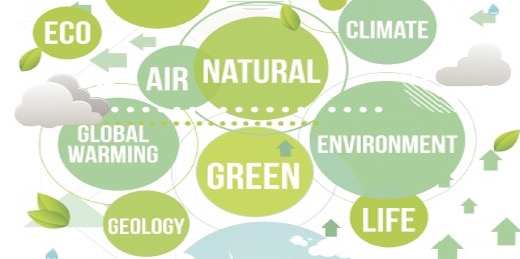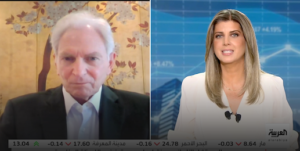The article titled “The Twin Revolutions of Clean Energy & AI will conflate”, appeared in The National on 19th April, 2018 and is posted below. Click here to access the original article.
The speed of transition to a new global energy mix has accelerated in the past decade.
A changing global economic geography with a shift towards fast-growing, energy-hungry emerging economies (China specifically) as the main growth engines meant a corresponding increase in energy demand that propelled energy prices upwards.
Oil prices hit an all-time high above $147 in July 2008, and in August 2013 were around $115. High oil prices provided an incentive for nations (especially emerging ones that ran high oil trade deficits), households and businesses to find substitutes for fossil fuels and to lower energy intensity.
Concurrently, the OECD countries implemented energy efficiency policies aimed at energy saving, leading to a trend decline in energy-used-to-GDP ratios by some 1 per cent to 2 per cent per annum, and breaking the historical link between economic growth and energy demand. Two additional factors supported the acceleration in energy transition: technological innovation and growing awareness of climate-change risks. Innovation in hydraulic fracturing, or fracking, techniques to extract tight oil resulted in the shale revolution and a rapid growth of on-shore oil production in the US.
Fracking technology has diffused internationally and its cost has declined: the breakeven oil price for new shale oil wells ranges between $46-$55, while an oil price between $24 and $38 would cover operating expenses in the US.
Technological innovation and investment have also dramatically cut the cost of renewable energy. Since 2009, the global benchmark levelised costs of electricity for solar PV has tumbled by 77 per cent, and for onshore wind by 38 per cent, while the lithium-ion battery price index shows a decline from $1,000 per kWh in 2010 to $209 per kWh in 2017. Declining battery costs means falling energy storage costs, which addresses renewable energy’s intermittency problem.
The decline in battery storage costs also means a potential revolution in international trade in renewables-based chemicals and fuels.
Government policies to curb climate change alongside technological advances and rapidly falling costs for solar and wind power has meant that renewables are becoming increasingly competitive, resulting in unsubsidised clean-energy world records last year.
There is no longer a need to subsidise renewable energy system solutions: global renewable energy prices will be competitive with fossil fuels by 2019 or 2020. There has also been a massive shift in public opinion and awareness of the implications of global warming.
Addressing the risks of climate change has become a key policy priority embodied in the COP21 commitments. All nations (except the US under the Trump government) have committed to reduce emissions by at least 20 per cent compared to business as usual by 2030. The subsequent COP22 and COP23 commitments have all seen unwavering support from countries across the globe (again excepting the US).
The implication of the above trends will be a permanent and persistent secular downward shift in the demand for fossil fuels, putting downward pressure on oil prices.
This is the New Oil Normal. For fossil fuel producers and exporters like the GCC, the risk is that their vast hydrocarbon reserves will become “stranded assets”: they will no longer be able to earn an economic return.
New investment in clean energy reached $333.5 billion in 2017, up 3 per cent from 2016. A record 157 gigawatts of renewable power were commissioned in 2017, up from 143 gigawatts in 2016, and far outstripping the 70 gigawatts of net fossil fuel generating capacity added last year. Solar alone accounted for 98 gigawatts, or 38 per cent of the net new power capacity coming on stream during 2017.
A regional comparison shows that the balance of investment has shifted from Europe as the largest-investing region to Asia, where China set a new record for clean energy investment in 2017.
The world is also increasing investments in clean technologies. A transport and mobility revolution will lead to cleaner, healthier cities for increasingly urbanised populations – not just “smart cities”, but also “clean cities”.
We are witnessing the birth of twin revolutions, which will conflate: artificial intelligence and blockchain technologies are fusing with new energy. AI is supporting what’s come to be known as the Fourth Industrial Revolution: think energy and water digitisation, smart grids, smart meters, “deep learning”, demand management and digital asset management (where machine learning algorithms collate, compare, analyse and highlight risks and opportunities across a utility’s infrastructure), among others.
Blockchain technology has the potential to offer a reliable, low-cost way for financial and/or operational transactions to be securely recorded and validated across a distributed network with no central point of authority, leading to a greater decentralisation of energy systems. Peer-to-peer energy trading, the ability of neighbouring homes – “prosumers” – to sell solar energy to one another as well as to a shared grid is already being tested.
The challenge to the widespread adoption of blockchain technologies will be the development of an enabling legal and regulatory framework. Country policy frameworks are needed to focus on clean technology investments, innovation and commercial conversion, in addition to “soft” and “hard” investments to facilitate and integrate the twin revolutions of clean energy and AI and blockchain technologies.
The UAE was the first mover on renewable energy in the GCC region.
With its aim to generate 75 per cent of its electricity from renewables by 2050, it is no surprise that it is among the top 20 nations investing more than $1bn in clean energy. Saudi Arabia’s recent announcement of a massive 200 gigawatts solar power development in the Saudi desert with SoftBank would be the world’s biggest solar project and would also be about 100 times larger than the next-biggest proposed development.
In a bid to lower dependence on fossil fuels, and as tariffs drop for solar photovoltaic and concentrated solar power projects, the GCC countries are enabling faster growth of their renewables sector. While Saudi Arabia and the UAE are investing in clean energy, government policies should support innovation in clean technology. The Global Cleantech Innovation Index explores where, relative to GDP, entrepreneurial clean technology companies are most likely to emerge from over the next 10 years – and why. Saudi Arabia, the only ranked nation from the region, scores low. One of the areas where countries in the region lag is their ability to convert inputs to innovation (such as pro-innovation policies by the government, infrastructure for renewables etc) to output (for example, listed clean technology companies, environmental patents, early-stage private investments etc). It is time to seize the day and develop tech alliances as well as R&D partnerships with the EU, China and clean-technology innovators.
Despite COP commitments, it is increasingly unlikely that we will be able to keep global warming below 2°C: the world is headed for irreversible climate change. Our best hope is to increase energy efficiency, and accelerate the global adoption of intelligent renewable energy systems and clean technology for our cities, businesses and transport systems in order to rapidly change the global energy mix and mitigate the risks of catastrophic climate change.
The Twin Revolutions of Clean Energy & AI will conflate: Article in The National, 19 Apr 2018
21 April, 2018
read 4 minutes
Read Next
media page
Comments on Saudi Arabia’s economic diversification in Al Arabiya News, 8 Apr 2024
Dr. Nasser Saidi’s comments appeared in an Al Arabiya News article titled “Saudi Arabia’s economic
9 April, 2024
media page
“Economic diversification is the GCC’s top priority”, Op-ed in Arabian Gulf Business Insight (AGBI), 3 Apr 2024
The opinion piece titled “Economic diversification is the GCC’s top priority” appeared in the Arabian
4 April, 2024
TV and radio
Interview with Al Arabiya (Arabic) on Fed interest rates, 20 Mar 2024
In this interview with Al Arabiya aired on 20th March 2024, Dr. Nasser Saidi discusses
21 March, 2024





